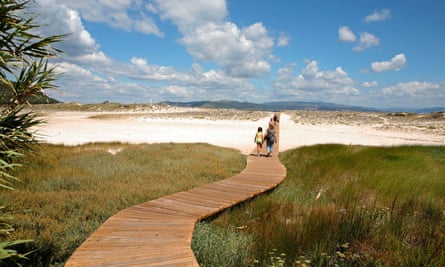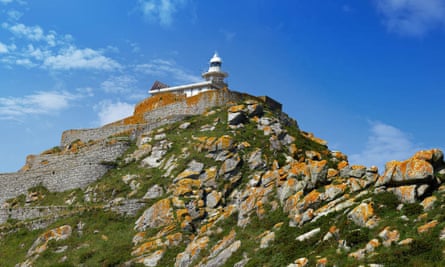As with all the best adventures, we never actually intended to go to the Islas Cíes. The beaches of northern Galicia were our destination. Well, they were until my wife clicked her weather app and saw blanket rain for a week. Suddenly we weren’t going north after all.
Travelling up from Portugal, we had got as far as the industrial port city of Vigo, which has a sunnier climate than northern Galicia. Without delay, we hit the internet in search of a plan B. One option kept popping up: the Islas Cíes (Illas Cíes in Galician) off the west coast. The images looked amazing: crystalline waters, tree-lined coasts, forest-covered mountains and white beaches.
All the same, I wasn’t convinced. For one, I had never heard of them. Second, was a near-uninhabited archipelago in the Atlantic Ocean really where we wanted to spend our holidays? There were no cars, no nightlife, no hotels and nothing to stop my kids landing up in Newfoundland should they happen to get swept out by the tide.
In the end, it was the kids (we have two boys, aged 9 and 10) who decided for us. Legend has it that the fleet of Francis Drake (still called “the pirate Drake” in these parts) used to hide out in the archipelago’s secluded coves. There’s even talk of buried loot. So these are real-life treasure islands, basically. Once they were aware of these salient facts, there was no question: we were going.
As if to get us into the buccaneering spirit, an angry squall was blowing as the ferry left the Bay of Vigo – the setting of a chapter in Jules Verne’s Twenty Thousand Leagues Under The Sea. After a bumpy 40-minute ride, the islands came into view.
For once, it seemed the images on the internet had not been subject to any embellishment. Even under that first afternoon’s leaden skies, the Cíes’ natural, untamed beauty was undeniable. The good weather soon returned and for four glorious days we simply sat back and lapped it all up: bathing in the sea, playing on the sand, napping in the shade.
Enchanting as the islands certainly are, their magic does not lie in their natural assets alone. Yes, the scenery is stunning. Yes, it feels like a troupe of cutlass-wielding pirates could land on the beach any minute. But what also makes the Cíes islands stand out is they way they have been organised as a holiday destination: to my mind, they are a world-class example of eco-tourism done well. So what’s their secret?

Strange as it may sound for a place with a pirate past, rules play a big part in making great holidays in the Cies. The Spanish national park authority, which manages the islands, loves its reglas. No leaving rubbish. No wandering off the paths. No camp fires. No loud music. No fishing. No unauthorised camping. No harming the animals (even when they steal your son’s ice-cream). No removing shells or sand, stones or plants.
It all sounds strict, for sure, yet the reality was very different. Everyone is left to their own devices. This is self-policing at its best: a sort of “please leave this facility as you would like to find it” philosophy for an entire archipelago.

In fact, the only officialdom we saw on our four day-visit was a group of bib-wearing volunteers. Far from brandishing rulebooks, they were there to pick up litter that had washed up on the tide.
Of all the rules, two stood out: no cars and no more than 2,200 visitors a day. The result is a wonderful, back-to-nature tranquillity. The main islands – Monteagudo, or North Island, and Montefaro (also known as Lighthouse or Middle Island) – cover between them around 4.5 sq km, so there’s more than enough space for everyone.
Plus, most folk tend to stick to the main beaches. With its travel brochure looks, the sweeping white Praia das Rodas, which links the two main islands, attracts the lion’s share of attention. But walk a little and you’ll have the protected coves of Praia de Nosa Señora or Praia das Figueres almost entirely to yourself.
What’s more, the draw of the islands’ salt-white sands leaves its inland haunts even more uncluttered. Of the network of well-signposted trails, the two most rewarding paths head up to Monte Faro, the highest of the islands’ three lighthouses (at 175 metres), and to the panoramic viewpoint of Alto do Principe (111 metres). Both are steep in sections but perfectly doable, as my two pre-teen children attested (albeit spurred on by the hope of buried treasure).
For me, the second standout of this Galician gem is its spirit of egalitarianism. On Cíes, no one cares what brand of sunglasses you wear or if you own a yacht. There’s no posh hotel sitting on a headland, no private marina in the bay. Like shipwrecked sailors, you’re all in the same boat – or, more accurately, on the same desert island.

The archipelago offers just one place to stay: Camping Islas Cíes. It’s a no-fuss affair, with clean shower blocks, a well-stocked shop and exceptionally friendly staff. Although there are pitches aplenty, we were persuaded by the promise of proper beds to opt for a fixed, family-size “bungalow” tent.
For sporty types, there are snorkelling lessons (€30) or kayaking (€35). Boat trips can also be arranged around the archipelago’s third island, the Robinson Cruso-esque Isla de San Martiño. For energetic kids (and snoozy parents), the campsite organises free children’s activities every morning and evening.
The islands have three restaurants, all with breezy terraces. Stick to the fish. On the menu are bream, bass, monkfish, tuna, mackerel, sardines and turbot, to name but a few. All are caught the same day and taste particularly divine grilled. At around €14-18 for a main dish, prices aren’t cheap but most portions are big enough for two. Prices in doubloons, meanwhile, are open to negotiation – especially if you’re holding a cutlass.
